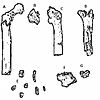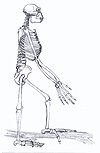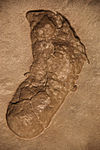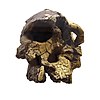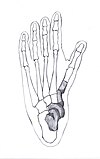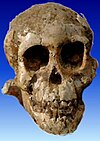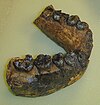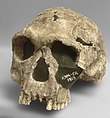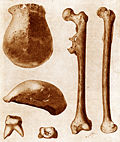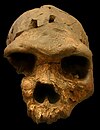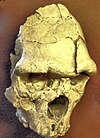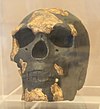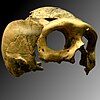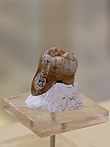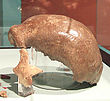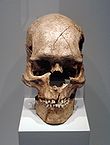Die folgenden Tabellen geben einen Überblick über einige bemerkenswerte Funde homininer Fossilien , die im Zusammenhang mit der Stammesgeschichte des Menschen und dem Prozess der Hominisation stehen. Da es tausende solcher Fossilien gibt, besteht hierbei kein Anspruch auf Vollständigkeit, vielmehr sollen die wesentlichsten Funde zusammengestellt werden.
Die Auflistung erfolgt anhand des Alters, welches durch radiometrische oder relative Datierung bestimmt wurde. Die Artbezeichnung entspricht dem momentanen Konsens. In Fällen, in denen keine wissenschaftliche Übereinkunft besteht, werden die übrigen Klassifikationen mit angegeben. Abgelehnte Bezeichnungen finden sich unter Umständen im Artikel zum jeweiligen Fossil.
Nicht alle vorgestellten Fossilien werden als direkte Vorfahren von Homo sapiens
Abbildung Name Alter Art Datum der Fundort Erstbeschreibung TM 266-01-060-1 7–6 mya Sahelanthropus tchadensis Holotypus )2001 Tschad Michel Brunet BAR 1000a'00 6 mya Orrorin tugenensis Holotypus )2000 Kenia Martin Pickford , Kiptalam Cheboi, Dominique Gommery, Pierre Mein, Brigitte Senut ALA-VP 1/20 5,5–5,8 mya Ardipithecus kadabba Holotypus )2001 Äthiopien Yohannes Haile-Selassie ARA-VP-6/500 4,4 mya Ardipithecus ramidus 1994 Äthiopien Tim White et al.KNM-KP 29281 4,2–3,8 mya Australopithecus anamensis Holotypus )1995 Kanapoi (Kenia )Meave Leakey et al.doppelte Fußspur 3,6 mya vermutlich Australopithecus afarensis 1976 Laetoli (Tansania )Mary Leakey LH 4 3,8–3,6 mya Australopithecus afarensis Holotypus )1974 Laetoli (Tansania )Mary Leakey Abbildung KSD-VP-1/1 3,58 mya Australopithecus afarensis 2005 Äthiopien Yohannes Haile-Selassie [1] KNM-WT 40000 3,5 mya Kenyanthropus platyops Holotypus )1999 Kenia Justus Erus Stw 573 3,3 mya (?) Australopithecus spec. 1994 Südafrika Ronald J. Clarke DIK 1-1 („Selam“)3,3 mya Australopithecus afarensis 2000 Äthiopien Zeresenay Alemseged AL 200-1 3,2–3,0 mya Australopithecus afarensis 1975 Äthiopien Donald Johanson Abbildung AL 129-1a / -1b 3,4 mya Australopithecus afarensis 1973 Äthiopien Donald Johanson Abbildung KT-12/H1 3,5–3,0 mya Australopithecus bahrelghazali Holotypus )1993 Tschad Michel Brunet AL 288-1 3,2 mya Australopithecus afarensis 24. November 1974 Äthiopien Donald Johanson AL 333 3,2 mya Australopithecus afarensis 2. November 1975 Äthiopien Michael E. Bush AL444-2 bei AL 444-2 3,0 mya Australopithecus afarensis 26. Februar 1992 Äthiopien Yoel Rak Abbildung LD 350-1 2,8–2,75 mya Homo habilis Homo rudolfensis 2013 Äthiopien Chalachew Seyoum Abbildung STS 14 2,8–2,6 mya Australopithecus africanus 1947 Südafrika Robert Broom Abbildung STS 52 Australopithecus africanus STS 71 2,5 mya Australopithecus africanus 1947 Südafrika Robert Broom Kind von Taung 2,5 mya Australopithecus africanus Holotypus )1924 Südafrika Raymond Dart KNM-WT 17.000 2,5 mya Paranthropus aethiopicus 1985 Kenia Alan Walker BOU-VP-12/130 Erstbeschreibung BOU-VP-12/130 2,5 mya Australopithecus garhi Holotypus )1997 Äthiopien Yohannes Haile-Selassie UR 501 2,4 mya Homo rudolfensis 1991 Malawi Friedemann Schrenk RC 911 bei palaeo.net (Memento Internet Archive RC 911 2,4 mya Paranthropus boisei 1996 Malawi Friedemann Schrenk AL 666-1 2,3 mya Homo Homo habilis 1994[2] Äthiopien Sts 5 2,16–2,05 mya Australopithecus africanus 1947 Südafrika Robert Broom DNH 134 2,04–1,95 mya Homo erectus 2020 Südafrika Andy Herries TM 1517 2,0 mya Paranthropus robustus 1938 Südafrika Gert Terblanche MH1 2,0 mya Australopithecus sediba Holotypus )2010 Südafrika Lee Berger
2 bis 1 Million Jahre Abbildung Name Alter Art Datum der Fundort Erstbeschreibung
KNM-ER 1813 1,9 mya Homo habilis 1973 Kenia Kamoya Kimeu KNM-ER 1470 1,9 mya Homo rudolfensis Holotypus )1972 Kenia Bernard Ngeneo SK 48 1,8 mya Paranthropus robustus 1948 Südafrika Robert Broom OH 5 Peninj 1 )1,8 mya Paranthropus boisei Holotypus )1959 Tansania Mary Leakey OH 8 (Hand) bei OH 8 1,8 mya Homo habilis 1960 Tansania Jonathan Leakey OH 24 1,8 mya Homo habilis 1968 Tansania Peter Nzube OH 62 bei msu.edu OH 62 1,8 mya Homo habilis 1986 Tansania Tim White OH 65 bei talkorigins.org OH 65 1,8 mya Homo habilis 1995 Tansania Fidelis Masao D 2700 1,8 mya Homo erectus ergaster georgicus 2001 Georgien OH 7 1,75 mya Homo habilis Holotypus )1960 Tansania Jonathan Leakey KNM-ER 3733 1,75 mya Homo erectus H. ergaster 1975 Kenia Bernard Ngeneo KNM-ER 1805 1,74 mya Homo habilis Koobi Fora , Kenia STW 53 bei StW 53 2–1,5 mya Homo habilis „Homo gautengensis “ )1976 Südafrika A. R. Hughes SK 847 1,8–1,5 mya Homo erectus Homo ergaster „Homo gautengensis “ 1969 Südafrika Ronald J. Clarke DNH 7 bei DNH 7 2–1,5 mya Paranthropus robustus 1994 Südafrika André Keyser SK 46 2–1,5 mya Paranthropus robustus 1949 Südafrika Robert Broom OH 16 1,7 mya Homo habilis 1963 Tansania Maiko Mutumbo KNM-ER 406 1,7 mya Paranthropus boisei 1969 Kenia Richard Leakey KNM-ER 732 1,7 mya Paranthropus boisei 1970 Kenia Richard Leakey KNM-ER 23000 Sangiran 4 1,6 mya Homo erectus 1939 Java G.H.R. von Koenigswald [3] OH 13 bei msu.edu OH 13 1,6 mya Homo habilis 1963 Tansania Louis Leakey KNM-WT 15000 1,5 mya Homo erectus H. ergaster 1984 Kenia Kamoya Kimeu KNM-ER 3883 1,6–1,4 mya Homo erectus H. ergaster Kenia Richard Leakey Peninj-Unterkiefer bei Peninj 1 oder1,5 mya Paranthropus boisei 1964 Peninj, Tansania Kamoya Kimeu Chellean OH 9 bei OH 9 1,5 mya Homo erectus 1960 Tansania Louis Leakey KNM ER 992 bei msu.edu KNM-ER 992 1,5 mya Homo erectus Holotypus von H. ergaster 1971 Kenia Richard Leakey KGA 10-525 1,4 mya Paranthropus boisei 1993 Äthiopien A. Amzaye ATD6-5 ca. 1,2 mya Homo antecessor Holotypus ) Homo erectus 1995 Sierra de Atapuerca José María Bermúdez de Castro Sangiran 17 ca. 1,25 mya Homo erectus 1969 Java Herr Towikromo
1 Million bis 100.000 Jahre Abbildung Name Alter Art Datum der Fundort Erstbeschreibung Sangiran 2 ca. 1,5 mya Homo erectus 1937 Indonesien G.H.R. von Koenigswald Trinil 2 oderPithecanthropus- 1Java-Mensch 1,0–0,7 mya Homo erectus Holotypus )1891 Indonesien Eugène Dubois Dinaledi Hominin 1 (DH1) inmitten von 1550 Knochen und Zähnen von 15 Individuen 0.912 mya (wahrscheinlichstes Alter) Homo naledi Holotypus )2013 Südafrika Lee Berger et al.Ternifine 1–3 bei scientificlib.com Tighenif 1 Atlanthropus mauritanicus 700 ka (?) Homo erectus 1955 Ternifine (Tighenif), Algerien Camille Arambourg Hexian PA830 PA 830 Homo erectus Kreis He , China Zhoukoudian XII Zhoukoudian XII Homo erectus Zhoukoudian , China Bodo 1 600 ka Homo erectus 1976 Äthiopien B. Asfaw GPIH.1Unterkiefer von Mauer 600 ka oder 500 ka Homo heidelbergensis Homo erectus heidelbergensis (Typusexemplar)1907 Mauer (Baden) , Deutschland Daniel Hartmann Peking-Mensch oder Sinanthropus pekinensis 770, 600 und 500 ka Homo erectus 1921–1937 Peking Otto Zdansky , Davidson Black Atapuerca 5 („Miguelón“)ca. 500–300 ka Homo heidelbergensis 1992 Spanien J. M. Bermúdez de Castro Vértesszőlős I und II (Homo erectus palaeohungaricus )500–350 ka Homo erectus 1965 Vértesszőlős , Ungarn Andor Thoma , 1966Ndutu 1 400–200 ka Homo erectus archaischer Homo sapiens ?1973 Ndutu-See, Tansania Amini Mturi Abbildung Salé 1 400 ka (?) Homo erectus archaischer Homo sapiens ?1971 Salé , Marokko Jean-Jacques Jaeger Arago XXI + Arago XLVIIMensch von Tautavel ) 400 ka Homo erectus tautavelensis Homo heidelbergensis 1971 Tautavel , Frankreich Henry de Lumley Petralona 1 Petralona 1 500–250 ka Homo heidelbergensis 1960 Griechenland fondationiph.org Hathnora 1 500–200 ka Homo erectus H. erectus narmadensis ) oderHomo heidelbergensis 5. Dezember 1982 Indien Arun Sonakia Swanscombe-Schädel 400 ka Homo heidelbergensis 1935 England Alvan T. Marston Homo erectus bilzingslebenensis 400–350 ka Homo erectus 1972 Bilzingsleben , Deutschland Emanuel Vlček , 1978Homo steinheimensis 350 ka Homo heidelbergensis 1933 Steinheim an der Murr , Deutschland Irhoud 1 300 ka Archaischer Homo sapiens 1961 Djebel Irhoud , Marokko Irhoud 2 300 ka Archaischer Homo sapiens 1963 Djebel Irhoud , Marokko Irhoud 3 (Kiefer) bei Irhoud 3 300 ka Archaischer Homo sapiens 1968 Djebel Irhoud , Marokko Dali-Schädel „Dali-Mensch “ 300–260 ka Homo erectus 1978 China Shuntang Liu Ngandong 7 250 ka Homo erectus 1931 Indonesien C. ter Haar und G.H.R. von Koenigswald Saccopastore 1 250 ka Homo neanderthalensis 1929 Italien A. Giovannini und V. Casorri Ehringsdorfer Urmensch 240–120 ka Homo neanderthalensis 1908 Ehringsdorf , Deutschland Gustav Schwalbe , 1914, Hans Virchow , 1914, 1920, Emanuel Vlček , 1993Kabwe 1 300–200 ka Homo rhodesiensis Holotypus ) Archaischer Homo sapiens ? Homo erectus 1921 Nordrhodesien (heute: Sambia )Tom Zwiglaar LH 18 200 ka Archaischer Homo sapiens 1976 Tansania Day et al. 1980[4] Omo 1 195 ka Archaischer Homo sapiens 1967/2001 Äthiopien Richard Leakey Omo II Omo 2 195 ka später Homo erectus Archaischer Homo sapiens 1967 Äthiopien Richard Leakey Herto-Schädel 160 ka Archaischer Homo sapiens „Homo sapiens idaltu “ 1997–2003 Herto (Mittlerer Awash , Äthiopien )Tim White Altamura-Mann 172–130 ka Homo neanderthalensis 1993 Altamura , Italien Eligio Vacca Abbildung Singa 1 150–120 ka Archaischer Homo sapiens 1924 Singa , Sudan W.R.G. Bond Krapina 3 130 ka Homo neanderthalensis 1899 Kroatien Dragutin Gorjanović Kramberger Tabun 1 Tabun C1 120 ka Homo neanderthalensis 1967–1972 Israel Arthur Jelinek
100.000 bis 50.000 Jahre Abbildung Name Alter Art Datum der Fundort Erstbeschreibung Klasies-Fragmente Klasies-River-Höhlen 125–75 ka Homo sapiens ab 1960 Südafrika Ray Inskeep , Robin Singer , John Wymer , Hilary John Deacon Skhul V ca. 100 ka Homo sapiens 1933 Skhul-Höhle , Karmel , Israel Theodore D. McCown und H. Moivus, Jr. Qafzeh IX Qafzeh IX ca. 100 ka Homo sapiens 1933 Qafzeh-Höhle , Israel Theodore D. McCown und H. Moivus, Jr. Skhul IX Neandertaler ?später Archaischer Homo sapiens ?Skhul-Höhle , Karmel , Israel Qafzeh VI Qafzeh VI ca. 100 ka Homo sapiens 1933 Qafzeh-Höhle , Israel Theodore D. McCown und H. Moivus, Jr. LB1 ca. 100–60 ka Homo floresiensis Holotypus )2003 Indonesien Peter Brown et al.La Ferrassie 1 70 ka Homo neanderthalensis 17. September, 1909 Frankreich R. Capitan und D. Peyrony Abbildung La Quina 5 Homo neanderthalensis Frankreich Abbildung La Quina 18 Homo neanderthalensis Frankreich Guattari 1 (ehemals Circeo I )Homo neanderthalensis 1939 Italien Alberto Carlo Blanc Gibraltar 1 70–45 ka Homo neanderthalensis 1848 Gibraltar NG 6 bei archaeology.nsc.ru NG 6 100–50 ka Homo erectus 1931 Indonesien C. ter Haar und G.H.R. von Koenigswald Abbildung Shanidar 1 80–60 ka Homo neanderthalensis 1961 Irak Ralph Solecki La Chapelle-aux-Saints 1 60 ka Homo neanderthalensis 3. August 1908 Frankreich A. und J. Bouyssonie , L. Bardon Amud 1 60–50 ka Homo neanderthalensis Amud-Höhle , Israel Abbildung Amud 7 55 ka Homo neanderthalensis Amud-Höhle , Israel
Abbildung Name Alter Art Datum der Fundort Erstbeschreibung Le Moustier 45 ka Homo neanderthalensis 1909 Frankreich Otto Hauser Denisova-Mensch 48–30 ka ungeklärt; 2010 Russland , Tibet Neandertal 1 40 ka Homo neanderthalensis Holotypus )1856 Neandertal , Deutschland Johann Carl Fuhlrott Spy I 42 ka Homo neanderthalensis 1886 Grotte de Spy , Jemeppe-sur-Sambre , Belgien Marcel de Puydt, Max Lohest Spy II 42 ka Homo neanderthalensis 1886 Grotte de Spy , Jemeppe-sur-Sambre , Belgien Marcel de Puydt, Max Lohest Mungo Man 40 ka Homo sapiens 1974 Australien Jim Bowler Mungo Lady 40 ka Homo sapiens 1969 Australien Jim Bowler Qafzeh VI Qafzeh 6 Homo sapiens Qafzeh-Höhle Abb. des Unterkiefer-Fragments Tianyuan 1 40 ka Homo sapiens 2003 VR China Hong Shang et al.Hofmeyr-Schädel 36 ka Homo sapiens 1952 Südafrika Cro-Magnon 1 30 ka Homo sapiens 1868 Frankreich Édouard Lartet Predmosti 3 Predmost 3 Homo sapiens Afalou 13 Wadi Kubbaniya Wadi Halfa 25 Minatogawa 1 Minatogawa 1 18–16 ka Homo sapiens 1970 Japan Tandou Kow Swamp 1 Kow Swamp 1–2213–9 ka Homo sapiens 1968 Australien A.G. Thorne Wadjak 1 12–10 ka Homo sapiens 1888 Indonesien Eugène Dubois SDM 16704 (Del Mar Man)11,3 ± 1,2 ka[5] Homo sapiens USA (Kalifornien )Combe Capelle (Grab)9 ka (Neudatierung 2011!) Homo sapiens 1909 Combe Capelle , FrankreichOtto Hauser Kennewick-Mann 9,3 ka Homo sapiens 1996 Kennewick , USA James C. Chatters Lothagam 4b (Lo 4b) 7,5 ka Homo sapiens 1965–1975 Kenia Ötzi („Mann vom Tisenjoch“)5,3 ka Homo sapiens 1991 Ötztaler Alpen (zwischen Österreich und Italien)Helmut und Erika Simon Tepexpan-Mensch 5 ka Homo sapiens 1947 Mexiko H. de Terra Cerro Sota 2 [6] 3,7 ka (BP) Homo sapiens 1936 Chile Junius Bird Homo sapiens balangodensis ?? Homo sapiens 1969 Sri Lanka P. E. P. Deraniyagala
AL – Afar Locality , Äthiopien ARA-VP – Aramis -Vertebrate Paleontology, Äthiopien AT – Atapuerca BAR – Baringo County , Kenia (Fundstätte Lukeino in den Tugen Hills) BEL – Belohdelie, Äthiopien (Middle Awash study area ) BK – Blimbing Kulon, Java , Indonesien BK – Bell’s Korongo, Olduvai-Schlucht BOD-VP – Bodo D’Ar -Vertebrate Paleontology, Äthiopien (Middle Awash study area ) BOU-VP – Bouri Vertebrate Paleontology, Äthiopien CGM – Cairo Geology Museum (heute: Ägyptisches Geologisches Museum) DIK – Dikika , Äthiopien DNH – Drimolen , Südafrika ER – East Rudolf (=Rudolfsee [heute:Turkana-See], Ostufer ), Kenia GDA – Gondolin, Südafrika IVPP – Institute of Vertebrate Paleontology and Paleoanthropology of the Chinese Academy of Sciences KB – Kromdraai , Südafrika KGA – Konso-Gardula , Äthiopien KNM-BK – Kenia Nationalmuseum -Baringo Kapthurin (Kapthurin-Formation, Tugen Hills, Baringo District) KNM-ER – Kenia Nationalmuseum-East Rudolf (=Rudolfsee [heute:Turkana-See], Ostufer ) KNM-WT – Kenia Nationalmuseum-Westufer Turkana-See KP – Kanapoi , Kenia KT – Koro Toro , Tschad OH – Olduvai Hominid, Tansania RC – Malema, Malawi-Rift SK, SKW, SKX – Swartkrans, Südafrika Sts, Stw, SE – Sterkfontein, Südafrika TM – Transvaal Museum, Südafrika TM – Toros-Menalla , Tschad UR – Uraha , Malawi WT – Westufer Turkana-See, Kenia
Siehe auch
Quellen
Belege ↑ Yohannes Haile-Selassie et al.: An early Australopithecus afarensis postcranium from Woranso-Mille, Ethiopia. In: PNAS .doi:10.1073/pnas.1004527107 ↑ W. H. Kimbel et al.: Late Pliocene Homo and Oldowan Tools from the Hadar Formation (Kada Hadar Member), Ethiopia. In: Journal of Human Evolution , Band 31, Nr. 6, 1996, S. 549–561, doi:10.1006/jhev.1996.0079 ↑ Fossiler, fragmentierter Schädel in drei Teilen. ↑ M. H. Day, M. D. Leakey und C. Magori: A new hominid fossil skull (L.H. 18) from the Ngaloba Beds, Laetoli, northern Tanzania. In: Nature. Band 284, 1980, S. 55–56, doi:10.1038/284055a0 ↑ doi:10.1017/S0033822200005981 , Volltext ↑ doi:10.4067/S0718-22442010000200009 = MAGALLANIA, (Chile), 2010. Vol. 38(2):133-149 


